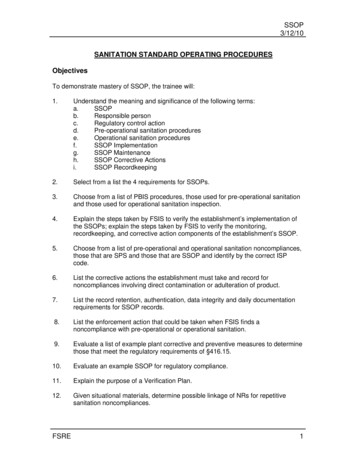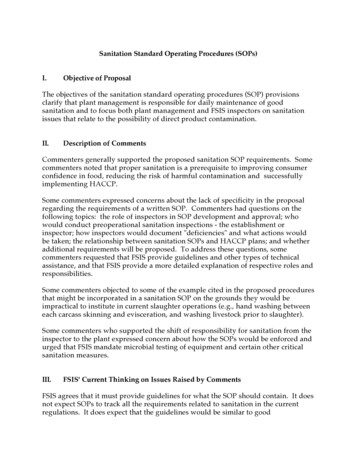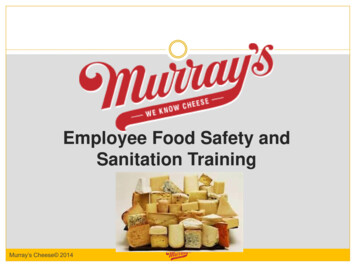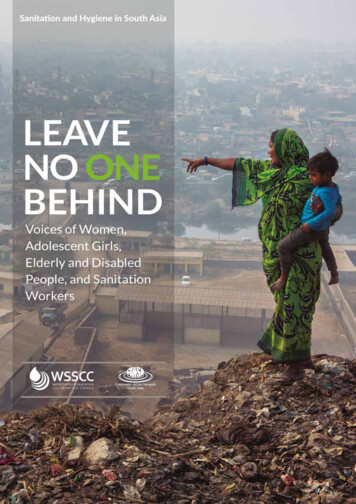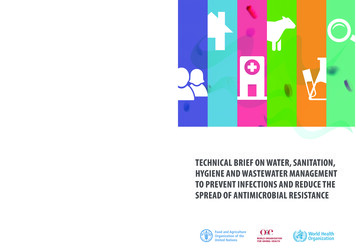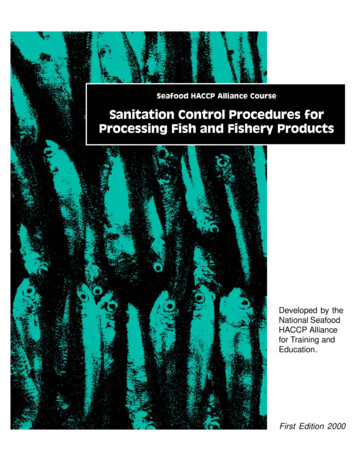
Transcription
Seafood HACCP Alliance CourseSanitation Control Procedures forProcessing Fish and Fishery ProductsDeveloped by theNational SeafoodHACCP Alliancefor Training andEducation.First Edition 2000
NATIONAL SEAFOOD HACCP ALLIANCEAlliance Steering CommitteeClaudio Almeida, Pan American Health OrganizationDane Bernard, National Food Processors Association, Washington, DCJames Cato, Florida Sea Grant College Program, Gainesville, FLBob Collette, National Fisheries Institute, Arlington, VAGeorge Flick, Virginia Polytechnic Institute and State University, Blacksburg, VAGary German, U.S. Food & Drug Administration, Rockville, MDKen Hilderbrand, Oregon State University, Newport, ORDon Howell, Southern States AFDO, North Carolina Department of Agriculture, Raleigh, NCGary Jensen, U.S. Dept. of Agriculture Cooperative Research, Education and Extension Serv., Washington, DCDon Kramer, University of Alaska, Anchorage, AKDon Kraemer, U.S. Food & Drug Administration, Washington, DCJohn Lattimore, Mid-Continential AFDO, Texas Department of Health, Austin, TXNick Majerus, North Central AFDO, U.S. FDA, Detroit, MIMike Moody, Louisiana State University, Baton Rouge, LAKen Moore, Interstate Shellfish Sanitation Conference (ISSC), Columbia, SCJim Murray, National Sea Grant Office, Silver Springs, MDAl Ondis, Central Atlantic States Association - AFDO, U.S. FDA, Baltimore, MDSteve Otwell, University of Florida, Gainesville, FLBob Price, University of California, Davis, CADenis Rooney, Association of Food & Drug Officials, York, PADan Sowards, Association of Food & Drug Officials (AFDO), Texas Department of Health, Austin, TXDebra DeVlieger, U.S. Food & Drug Administration, WADonn Ward, North Carolina State University, Raleigh, NCRichard Waskiewicz, Northeast AFDO, Massachusetts Department of Public HealthChris Wogee, Western AFDO, California Department of Health, Sacramento, CAKim Young, U.S. Food & Drug Administration, Washington, DCSanitation Control Procedures for Processing Fishand Fishery Products Editorial CommitteeBob Collettee, National Fisheries InstituteCusty Fernandes, Mississippi State UniversityGeorge Flick, Virginia Polytechnic Institute and State UniversityKen Gall, New York Sea GrantGary German, U.S. Food & Drug AdministrationDoris Hicks, University of DelawareKen Hilderbrand, Oregon State UniversityMike Jahncke, Virginia Polytechnic Institute and State UniversityDon Kraemer, U.S. Food & Drug AdministrationBob Metz, National Marine Fisheries ServiceMike Moody, Louisiana State UniversityKen Moore, Interstate Shellfish Sanitation ConferenceSteve Otwell, Chair, University of FloridaBob Price, University of California-DavisTom Rippen, University of MarylandDonn Ward, North Carolina State UniversityLisa Weddig, National Food Processors AssociationSteve Wilson, National Marine Fisheries ServiceKim Young, U.S. Food & Drug AdministrationFlorida Sea Grant - PO Box 110409 - Gainesville, FL 32611-0409 - 352-392-2801.Florida Sea Grant Report -119.
Seafood HACCP Alliance CourseSanitation Control Procedures forProcessing Fish and Fishery ProductsDeveloped by theNational SeafoodHACCP Alliancefor Training andEducation.First Edition 2000
ForewordNational Seafood HACCP AllianceThe National Seafood HACCP Alliance for Education and Training is simply a cooperative effort amongst existing industry and government programs sharing their responsibility to advance the safety of seafood products inthe United States, be they harvested, aquacultured or imported. Their approach is to provide uniform educationthrough courses designed for the diverse commercial sectors and the corresponding inspection authorities. Thecourses are further complimented with a “Compendium of Fish and Fishery Product Processes, Hazards, andControls” and the FDA’s “Fish & Fishery Products Hazards & Control Guide.” All training materials are notrestricted and are made available for public and international use.Following the initial project grant from the National Sea Grant College Program in 1993, the Seafood HACCPAlliance is now supported by a tripartite of funds from the U.S. Food and Drug Administration, the Associationof Food and Drug Officials and the National Sea Grant Office for educational activities through 2001. Theirefforts are still recognized by “Certificates of Course Completion” that are issued and recorded by the Association of Food and Drug Officials based in York, Pennsylvania. The Alliance activities, educational material andscheduled courses are posted on their adopted website, http://seafood.ucdavis.edu.The Seafood HAACP Alliance does not have regulatory authority and it does not address or set regulatory policyfor food safety. Their educational plan recognizes the essential role of state regulatory authorities, the educationalnetworks of Sea Grant and Cooperative Extension Services, the respective federal agencies and the industrytrade association in providing current and continuous educational support for commerce and public interests.SPECIAL NOTE: Although the Seafood HACCP Alliance does not enforce or set regulatory policy, theireditorial committees do provide recommendations through examples in their curricula that are intended to helpfirms comply with the prevailing regulations. These recommendations should not be considered regulatory requirements. The training materials try to distinguish specific regulatory requirements through references to therules or authorities.Seafood HACCP Alliance Training MaterialsSanitation Control Procedures for Processing Fish and Fishery Products, First edition January 2000, 203 pages. Manualavailable from Florida Sea Grant College Program, P.O. Box 110409, Gainesville, FL 32611-0409 (352) 392-2801.HACCP: Hazard Analysis and Critical Control Point Training Curriculum, Third Edition (English) July 1996, 276 pages,and Second Edition, 1997 (Spanish), UNC-SG-98-07. Manual available bound - North Carolina Sea Grant, Box 8605, NCState University, Raleigh, NC 27695-8605 or call 919/515-2454.Fish & Fishery Products Hazards & Control Guide, Second Edition, January 1998, 276 pages. Manual available boundNorth Carolina Sea Grant, Box 8605, NC State University, Raleigh, NC 27695-8605 or call 919/515-2454. Send inquiries toU.S. Food & Drug Administration, Docket Management Branch (HFA-305), Room 1-23, 12420 Parklawn Drive, Rockville,Maryland 20857 for docket number 93N-0195.Compendium of Fish and Fishery Product Processes, Hazards and Controls (continuous updates) available website - d.htmFuture EditionsThis manual, future additions and the latest updates are available at the following anual.htmii
Seafood HACCP Alliance CourseSanitation Control Proceduresfor Processing Fishand Fishery ProductsTable of ContentsINTRODUCTION .INTRO-1CHAPTER 1 SAFETY OF WATER . .1-1CHAPTER 2 CONDITION AND CLEANLINESS OFFOOD CONTACT SURFACES .2-1CHAPTER 3 PREVENTION OF CROSS CONTAMINATION .3-1CHAPTER 4 MAINTENANCE OF HAND WASHING,HAND SANITIZING, AND TOILET FACILITIES . .4-1CHAPTER 5 PROTECTION OF FOOD FROM ADULTERANTS. .5-1CHAPTER 6 PROPER LABELING, STORAGE, ANDUSE OF TOXIC COMPOUNDS . .6-1CHAPTER 7 CONTROL OF EMPLOYEE HEALTH CONDITIONS . .7-1CHAPTER 8 EXCLUSION OF PESTS . .8-1EXAMPLE SSOP PLAN AND SANITATION CONTROL RECORDS .SSOP-1APPENDICES . .APP-1Seafood HACCP Regulation (21 CFR, Part 123)Good Manufacturing Practices (GMP) Regulation (21 CFR, Part 110)Blank formsReferencesiii
Seafood HACCP Alliance CourseSanitation Control ProceduresforProcessing Fish and Fishery ProductsIntroductionThis course is intended to assist the seafood industry in developing and implementing ‘SanitationControl Procedures’ as mandated by the U.S. Food and Drug Administration (FDA). This regulation iscommonly known as the “Seafood HACCP Regulation” which became effective December 18, 1997.Since this date, seafood processors have been required to ‘monitor’ sanitary control procedures usedduring processing in order to show their conformance with good sanitary conditions and practices.Likewise, seafood importers must verify that the seafood being imported was processed in accordancewith the same FDA mandated HACCP requirements that include sanitation monitoring proceduresand records. This is a new and challenging regulatory approach which will require understanding andcooperation by all levels of the seafood industry and the respective inspection authorities.I-1.Course Purpose:To assist industry in developing and implementing Sanitation ControlProcedures as mandated by FDA’s “Seafood HACCP Regulation”(21CFR, Parts 123 & 1240).Course Objectives:u How to develop Sanitation Standard Operating Procedures (SSOP);u How to conduct monitoring for sanitary “conditions and practices”; andu How to maintain sanitary conditions and practices.Intro-1FDA
Seafood HACCP Alliance CourseCourse ApplicationThis Sanitation Control Procedures training will apply to fish and fishery product processing defined as:Fish, which means fresh or saltwater finfish, crustaceans, other forms of aquatic animal life (including,but not limited to, alligator, frog, aquatic turtle, jellyfish, sea cucumber, and sea urchin and the roe ofsuch animals) other than birds and mammals, and all mollusks, where such animal life is intended forhuman consumption;Fishery product, which means any human food product in which fish is a characterizing ingredient; andProcessing which, with respect to fish and fishery products, means; handling, storing, preparing, heading, eviscerating, shucking, freezing, changing into different market forms, manufacturing, preserving,packing, labeling, dockside unloading, or holding.Processing as defined by the seafood HACCP regulations does not apply to:* Harvesting or transporting fish or fishery products, without otherwise engaging in processing.* Practices such as heading, eviscerating, or freezing intended solely to prepare a fish forholding on-board a harvest vessel.* The operation of a retail establishment.Course ContentRather than a basic food sanitation course, this training format features the regulatory requirements for monitoring sanitary conditions and practices, encourages development of written SSOP, andoffers background information on basic sanitation.Course participants should learn how to draft SSOPplans and build sanitation monitoring programs to address eight key sanitary conditions. Proper plansand monitoring should lead to proper practices. Background information is provided to assist in developing proper sanitary practices. Course completion is only a start. The primary measure of successwill be based on in-plant performance.I-2.Elements of the Course:1. Sanitation Standard Operating Procedures (SSOP);2. Sanitation Monitoring and Corrections; and3. Basic Sanitation in Processing.The course includes a chapter for each of the eight key sanitation conditions or areas specified by the FDA Seafood HACCP Regulations. Each of these course chapters are organized in threeparts -- 1) required sanitation monitoring, corrections and records; 2) related background informationon sanitation; and 3) example sanitation control guides.Intro-2
IntroductionI-3.Course Chapters 3 Parts:1. Sanitation monitoring, corrections and records;2. Background information on sanitation; and3. Sanitation Control Guides (examples).I-4.Course Agenda -- Sanitation Control Procedures8:00 a.m.Registration and Welcome8:30 a.m.Introduction9:30 a.m.Safety of Water10:00 a.m.Break10:30 a.m.Condition and Cleanliness of Food Contact Surfaces (two parts)Lunch1:15 p.m.Prevention of Cross-Contamination1:45 p.m.Maintenance of Hand Washing, Hand Sanitizing and Toilet Facilities2:15 p.m.Protection of Food from Adulterants and Proper Labeling, Storageand Use of Toxic Compounds2:45 p.m.Break3:15 p.m.Control of Employee Health Conditions3:45 p.m.Exclusion of Pests4:15 p.m.Example of SSOP Plan and Sanitation Control RecordsAdjournIntro-3
Seafood HACCP Alliance CourseThe chapters progressively build and explain a typical monitoring form for both daily and monthlysanitation control records. The recording form used is taken from the Seafood HACCP Alliance’s“Encore” HACCP course to illustrate a variety of considerations in designing a monitoring record.The particular “Encore” Training form is not required to comply with the federal HACCP mandate,but it does include features that processors should consider in developing monitoring forms for theirspecific processing operations.The course offers a variety of monitoring forms to illustrate approaches to customizing thesanitation records to suit particular processing operations. Although, there are no federally mandatedfrequencies for sanitation monitoring for either daily or periodic records, the course suggests frequencies in monitoring that would satisfy conformance with the conditions and practices specified in theGood Manufacturing Practices (GMP). Frequency for monitoring must be appropriate to the plant andfood being processed.The chapters conclude with example “Sanitation Control Guides” that can be referenced whendeveloping a sanitation monitoring program (I-6). The Sanitation Control Guides are not specifiedregulatory requirements. They are simply provided as a guide or reference. Each guide deals with oneof the eight key sanitary conditions. These guides identify key sanitation concerns and provide examplesof problems and issues often encountered in processing. They list recommended controls, monitoringprocedures and corrections. The listed frequencies for monitoring are only recommendations which mayvary for particular processing conditions and foods. In most of the chapters, more than one SanitationControl Guide is provided because a variety of plant procedures may affect any one of the eight keysanitation conditions.The Sanitation Control Guides are not SSOP per se, but may be used as a foundation for developing company-specific SSOP. Sanitation Standard Operating Procedures should clearly list companyprocedures for complying with the sanitation monitoring requirements of the FDA Seafood HACCPregulation and the Good Manufacturing Practices (Appendix). A firm’s SSOP should include step-by-stepdetails, such as describing the type of sanitizers used, where they are used, how they are applied, whenthey are applied, and in what concentrations. A simple example of a complete SSOP plan is provided inthe last chapter, “Example SSOP Plan and Sanitation Control Records.” It contains a monitoring formthat is formatted differently than the example used in other parts of the course. This illustrates the needto use a form that matches each company’s SSOP. Regardless of the approach, any resulting SSOP planshould reflect the procedures and character of the particular processing operation.I-5.Frequency for MonitoringFrequency for monitoring sanitation practices and conditions arenot specified in the FDA Seafood HACCP Regulations, but arerecommended in this Alliance course as an optional guideline tohelp ensure conformance with the Good Manufacturing Practices(GMP) that should be appropriate to the plant and food beingprocessed.Intro-4
IntroductionI-6. Example Sanitation Control GuideSanitation Control GuideEntry date:Cleaning and SanitizingFDA Key Condition No. 2Concern: Food contact surfaces may appear clean but harbor pathogensExamples:Bacteria may be present in crevices, overlapping joints or hidden areas difficult to inspect. Clearly visiblesurfaces may be coated with invisible biofilms containing bacteria. Some surfaces may be stained withminerals or water scale making visual inspection difficult. Chemicals used for cleaning and sanitizing mustbe appropriate and effective without harming the equipment, utensils or environment of discharge.Controls and Monitoring:Visual check of all food contact surfaces for proper cleaning and sanitation. Use a strong flashlight or othershadow-free lighting source when inspecting hidden areas. Disassemble and inspect food contact equipment to identify areas which may trap soils. Frequency: Daily pre-op for raw seafood line, plus afterevery break for ready-to-eat line.Confirm visual checks with bacterial contact plates or luminometer. Frequency: Monthly or more frequently if results indicate. (Note: swabs are used in place of contact plates in areas that are difficult toaccess). Luminometer — weekly or more frequently if results indicate.Visually confirm that proper procedures, equipment and chemicals are used for cleaning and sanitizing.Use five-step approach. Use test papers to record proper strength for sanitizers. Frequency: Daily pre-opfor raw seafood line, plus after every break for ready-to-eat line.u Pans, knives, and other utensils are placed in a soak tank containing general purpose detergent (con-centration controlled by proportioner). After soaking 30 mins. the items are rinsed and dipped in sanitizer (100 ppm chlorine).u All processing waste removed from work areas, and tables and floors are dry cleaned. Tables arecleaned with general purpose detergents followed by rinsing then exposure to 200 ppm chlorine.Floors, splash zone of walls (4 feet above floor), and sinks are cleaned then sanitized with 400 ppmquats or 200 ppm chlorine.u Periodically (weekly) use an acid detergent to remove stains and scaleu Periodically switch (monthly) to another class of sanitizer to prevent selecting tolerant types ofmicroorganisms.Recommended Corrections:If surfaces are inadequately cleaned, fully reclean and resanitize following the five-step procedures.Check sanitizer concentrations. Train employees semiannually or more frequently if indicated by monitoring.Records:Daily Sanitation Control RecordContact Plate Record (confirmation)Employee Training RecordIntro-5
Seafood HACCP Alliance CourseSanitation Control Proceduresin the HACCP RegulationThe Seafood HACCP Regulation recommends (“should”) that each processor have and implement written Sanitation Standard Operating Procedures (SSOP), and requires (“shall”) that they monitorthe sanitary conditions and practices during processing. In turn, many states have adopted this regulatory approach and it is a recognized requirement for interstate and international commerce. This FDAregulation is specifically referenced as Title 21 in the Code of Federal Regulations (CFR), Parts 123 and1240 (21 CFR, Part 123 & 1240), “Procedures for the Safe and Sanitary Processing and Importing ofFish and Fishery Products.” This regulation became effective December 18, 1997. The specific wordingfrom the regulation is provided in the Appendix. A review of the rule is provided in Chapter 12, “TheSeafood HACCP Regulation” in the Alliance’s HACCP: Hazard Analysis and Critical Control PointI-7.Sanitation Control Procedures are an integral partof the Seafood HACCP Regulation:1. Processors ‘should’ have and implement a written SSOP plan;2. Processor ‘shall’ monitor the sanitary conditions and practices;3. Processors “shall” correct insanitary conditions and practices ina timely manner; and4. Processors “shall” maintain sanitation control records.Training Curriculum (see Chapter References). The CFR and Alliance Chapter should be referencedto better understand the basic HACCP requirements.FDA included sanitation control procedures as an integral part of the seafood HACCP regulations to encourage processors to pay more attention to routine sanitary practices. FDA felt the additionalcontrols were necessary because:-sanitation practices directly affect the microbiological safety of seafood products that arenot further cooked by the consumer, such as, ready-to-eat products, smoked products, rawmolluscan shellfish, and other fish that are consumed raw;-sanitation practices are relevant to the microbiological safety of seafood products even wherethese products are to be cooked by the consumer;-sanitation practices directly affect the chemical and physical safety of seafood products;-nearly half of the consumer complaints that FDA receives relating to seafood are related tothe processing plant or food hygiene; andIntro-6
Introduction- inspections conducted by FDA and the National Marine Fisheries Service (NMFS)demonstrate that a significant portion of seafood processors operate under poorsanitation conditions.According to existing laws, any food processed under ‘insanitary’ conditions is adulterated becausethe food may be contaminated with filth, or substances that could render the food injurious to health[Food Drug & Cosmetic Act, section 402(a)(4)]. The current Good Manufacturing Practice (GMP)regulations were issued (Chapter 21 CFR Part 110) to help prevent these problems. These GMP havebeen and continue to be applicable to all foods including fishery products. They outline the basicconditions and practices that must be followed in order to avoid adulteration. A complete copy ofthese regulations is contained in the Appendix.The new mandated sanitation control procedures focus on specific parts of the GMP. Theyintroduce new requirements for monitoring, corrections, and recordkeeping that are not specified inthe GMP. The HACCP-like features for monitoring and record keeping were considered necessary“to develop a culture throughout the seafood industry in which processors assume an operative rolein controlling sanitation in their plants.” In other words, application of the existing GMP across theseafood industry in both domestic and international settings was not evident at sufficient levels toadvance seafood safety. Monitoring and recording were deemed necessary to encourage appropriatesanitary conditions and practices on a more routine basis.I-8.Why Monitor Sanitation Control Procedures?“ . . . to develop a culture throughout the seafood industry inwhich processors assume an operative role in controlling sanitation in their plants.”Together the sanitation control procedures and GMP form the foundation for a complete seafood safety program topped with a HACCP program that is product and process specific. HACCPcannot succeed in a plant that does not have adequate GMP.I-9.Food Safety Control ProgramHACCPSanitation Control ProceduresGood Manufacturing Procedures (GMP)Intro-7
Seafood HACCP Alliance CourseCCP vs. Sanitation Control ProceduresA complete food safety program includes both a HACCP plan and the accompanying sanitationcontrol procedures based on GMP. Both components require monitoring, corrections and recordkeeping, yet there are a few regulatory subtleties that should be distinguished for each component.The HACCP plan for seafood safety is built on a hazard analysis that reveals specific criticalcontrol points (CCP) that must be monitored to ensure that a processing step or procedure is in controlso as to prevent, eliminate, or reduce to an acceptable level, any potential food-safety hazard. Thewritten HACCP plan specifies the various CCP for a particular process and details the critical limits,monitoring methods, corrective actions, verification procedures and records to be used to assure thatcontrol is maintained at a CCP.I-10.CCP: A step at which control can be applied and is essential toprevent or eliminate a food safety hazard or reduce it to an acceptable level.Sanitation Control Procedure: Procedure to maintain sanitaryconditions usually related to the entire processing facility or anarea, not just limited to a specific processing step or CCP.Some hazards are best controlled through sanitation control procedures. Relegating controlof a hazard to sanitation control procedures rather than HACCP does not minimize its importance. Itsimply may be the most appropriate means of control. Frequently, both HACCP and sanitation control procedures are necessary to control a hazard. For example, under HACCP a critical control pointis implemented at a smokehouse to make sure sufficient heat is applied to kill potential pathogenicbacteria. Sanitation monitoring to ensure proper employee hygiene and plant sanitation is necessaryto minimize the potential for recontaminating the product after smoking.Identified hazards . . .I-11. . . which are inherent to the product or are associated with a discreteprocessing step must be controlled with HACCP. Hazards associated withthe processing environment or personnel are usually better controlled withsanitation control procedures.Identified hazards which are inherent to the product or are associated with a discrete processingstep must be controlled with HACCP. Hazards associated with the processing environment or personnelare usually better controlled with sanitation control procedures. Sanitation monitoring can be used tocontrol hazards associated with the eight sanitation areas listed in the HACCP regulation and coveredin this course. Use HACCP to control product and process-related hazards identified in FDA’s Fishand Fishery Products Hazards and Controls Guide. Some examples of these distinctions are providedin Table I-12.Intro-8
IntroductionI-12. Differentiating HACCP and Sanitation Control ProceduresHazardControlType of ControlControl ProgramHistamineTime & temperatureof scombroid fishProduct specificCCPPathogen SurvivalTime & temperaturefor smoking fishProcessing stepCCPContamination withpathogensWash hands beforetouching productPersonnelSanitationContamination withpathogensLimit employee movement between rawand cooked areasPersonnelSanitationContamination withpathogensClean and sanitizefood contact surfacesPlant environmentSanitationChemicalcontaminationUse only food-gradegreasePlant environmentSanitationThe distinction between CCP and sanitation control procedures is not always clear. For thisreason, the Seafood HACCP regulation allows sanitary controls for safety to be included in the HACCPplan. In most situations, processors should not complicate the HACCP plan with sanitation monitoringrequirements that would be better served in sanitation control procedures. It would be difficult to assignand meet critical limits and corrective actions for certain sanitation controls and excessive sanitationmonitoring assigned at CCP could burden the HACCP plan and detract attention from critical processing procedures. Sanitary conditions usually relate to the entire processing facility or an area, not just toa limited or specific processing step or CCP. In some instances, a seafood processing operation maynot require a specific HACCP plan because the hazard analysis revealed no significant hazards, yet allprocessing firms must always monitor for sanitary conditions and practices.Specific Sanitation Control RegulationsRecommended SSOP Plan:I-13.“Each processor ‘should’ have and implement a written SSOPor similar document that is specific to each location where fishand fishery products are produced.”21 CFR, Part 123.11(a)Intro-9
Seafood HACCP Alliance CourseA written SSOP plan explaining the sanitation concerns, controls, in-plant procedures andmonitoring requirements is recommended, but not required by the FDA seafood HACCP regulation.This course encourages development and use of written SSOP plans and offers sanitation guidelines.I-14.SSOP plans:ü Describe the sanitation procedures to be used in the plant;ü Provide a schedule of these sanitation procedures;ü Provide a foundation to support a routine monitoring program;ü Encourage prior planning to ensure that corrections are taken when necessary;ü Identify trends and prevent recurrent problems;ü Ensure that everyone, from management to production workers, understands sanitation;ü Provide a consistent training tool for employees;ü Demonstrate commitment to buyers and inspectors; andü Lead to improved sanitation practices and conditions in the plant.I-15.Sanitation Monitoring Program“Each processor ‘shall’ monitor the conditions and practices during processing with sufficient frequency to ensure, at aminimum, conformance with these conditions and practicesspecified in the [GMP] that are appropriate to the plant and foodbeing processed.”21 CFR, Part 123.11(b)In developing the seafood HACCP regulation, FDA used findings from previous regulatoryinspections and consumer complaints to determine the most common sanitary problems. The results,based on inspections during 1991 - 1992 for nearly all domestic manufacturers in the FDA inventoryof seafood establishments, indicated that some processing firms had problems with general sanitationconditions in the processing area. For example, processing firms:- did not clean and sanitize their processing areas or equipment throughout the day’s production;- had employees that were not following proper sanitation practices in processing, packaging, orfinished product storage activities;- lacked hand sanitizers in their processing area or had sanitizers that werenot kept at proper sanitizing levels.Intro-10
IntroductionFDA combined their concerns into eight (8) areas of sanitation. This training program is builtaround these eight key areas of sanitation to be discussed in training as the EIGHT KEY SANITATIONCONDITIONS.I-16.FDA’s Eight Key Sanitation Conditions1. Safety of the water that comes in contact with food or foodcontact surfaces, or is used in the manufacture of ice;2. Condition and cleanliness of food contact surfaces,including utensils, gloves, and outer garments;3. Prevention of cross-contamination from insanitary objects tofood, food packaging material, and other food contact surfaces, including utensils, gloves, and other outergarments, and from raw product to cooked product;4. Maintenance of hand washing and sanitizing, and toiletfacilities;5. Protection of food, food packaging materials, and food contact surfaces from adulteration with lubricants, fuel, pesticides, cleaning compounds, sanitizing agents,condensate, and other chemical, physical, and biologicalcontaminants;6. Proper labeling, storage, and use of toxic com
Al Ondis, Central Atlantic States Association - AFDO, U.S. FDA, Baltimore, MD Steve Otwell, University of Florida, Gainesville, FL Bob Price, University of California, Davis, CA Denis Rooney, Association of Food & Drug Officials, York, PA Dan Sowards, Association of Food & Drug Officials (AFDO), Texas Department of Health, Austin, TX
